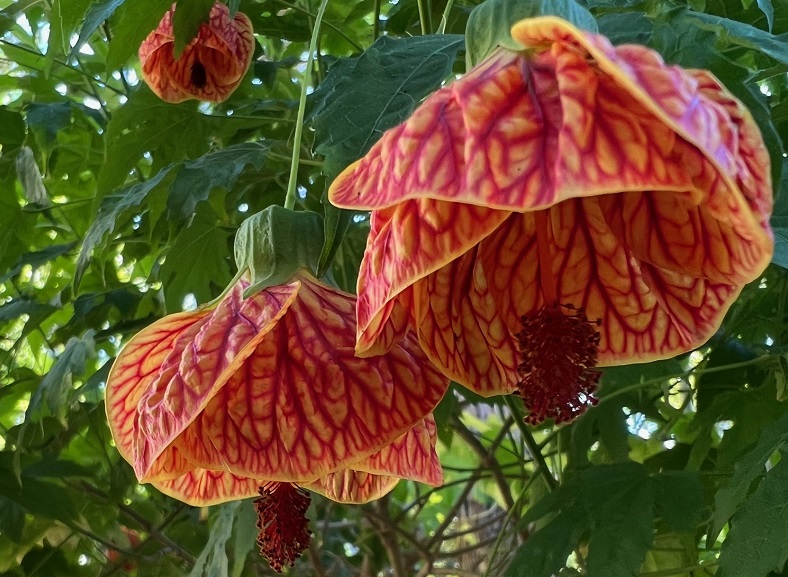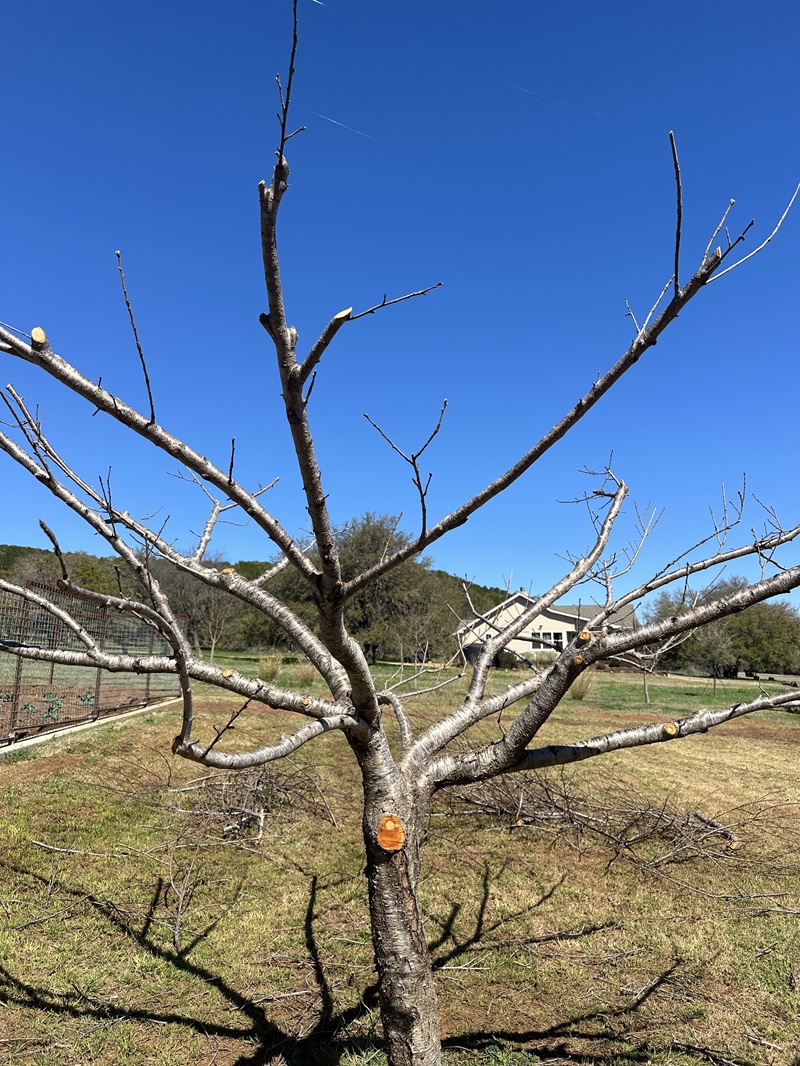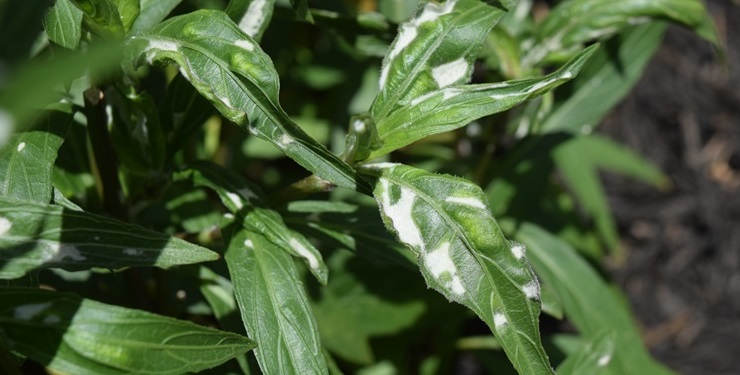I have been getting a lot of questions on whether this plant or that plant will be likely to recover. I think it is important to understand that the plants are still in the process of reacting to this freeze. They aren’t done yet!!!
The healthier a plant or tree was going into this freeze, the better the chance of recovery, especially with our native and adaptive species. In the coming weeks or even months, as trees and shrubs that still have the ability to put out new growth begin showing some green, we will also be experiencing some higher temperatures. High temperature and wind puts an added stress on the roots and vascular systems to be able to move enough water and nutrients through the plant as moisture is lost from the emerging leaves. Trees and shrubs that have had loss to the root system or damage to the vascular system will show symptoms at this time. This is why it is so hard to predict what the future holds for these trees and shrubs. Some may not show symptoms of stress until late spring or even summer.
I want to remind everyone not to jump to conclusions too early. All nurseries in Texas and Louisiana were heavily impacted by this freeze, and replacement plants of certain species may be limited. This was a significant event for everyone in Agriculture in these states, and it will take time to recover.
Personally, I am taking this opportunity to re-assess the plantings in my yard, and I think it will be a positive experience. Landscapes are dynamic, and we need to be prepared for change. This is harder for those of you with new landscapes, but it does give us the chance to realize that plants do not live forever. Many of our common landscape plants do have a “lifespan”. Texas Sage and Rosemary usually start to deteriorate after about 15 years. Even Salvia greggii get scraggly after about 5 years if not pruned correctly. I have lost many plants to fungal organisms in the soil, then had to replace them with plants that aren’t susceptible to that fungus. Nature is constantly changing, and we need to be prepared to change with it.
Live Oaks are shedding their leaves, as expected, and will begin leafing out soon. It is impossible to know what is going on inside the tree (the vascular system) and under the ground in the root system. I think that we may see the effects of the freeze on these trees for many months. Since we have not experienced the -1°F in some Central Texas locations in our lifetime, this will be a learning experience for us all. As I have said before, the health of the tree, location of the tree, moisture level in the soil and many other factors will determine the ultimate outcome. I am thinking positively until I know otherwise!
For those of you with Sandankwa Viburnum, it HAS been known to return from the roots, so be patient. Try to wait as long as you can to cut them back. We don’t want to encourage new growth that may be hit by a late freeze. Plants that are still viable will return in their own good time, if we let them.
Finally, for everyone with Rosemary that was affected by this freeze, if it is brown, it is safe to remove it now. Rosemary is one of the plants that does not come back from the roots and does not send out new growth from woody stems if you cut it back severely. I think we can all plan on replacing Rosemary this year.
Remember, we are all in this together, and we WILL recover from this freeze!





As with Rosemary, it would be nice if you can update us on the plants that will never come back. My pineapple guava looks like it’s bit the dust.
Yes, most of the Pineapple Guava looks pretty bad. Again, this is an unprecedented freeze event. I expect that some will show some growth rather late this spring from the base of the plant, but this is just an educated guess. Every situation may be different. The snow cover at the base of the trunk may have insulated it enough for it to come back. I can tell you that if it does come back from the base it will be slow. They are not a fast grower in the first place, and being a South American native, I think 15°F is probably it’s lower limit. I am going to wait to do anything to mine for a few months. Then we will see.
I replaced my Rosemary late last summer; five plants. They were doing well and growing but after the low 20s temperature that we have had, three of the five have turned brown. Your comment above does not offer much hope that they will recover in the spring. I suppose that I will need to replace. Are some varieties more cold hardy than is the trailing variety that I chose last time?
I’m not sure which zone you are in. Prostrate Rosemary is less winter hardy than Upright Rosemary. The most winter hardy Upright varieties that I am familiar with are Hill Hardy and Arp. You should check those varieties against the zone you live in.
Thank you Mary Kay. I will come and see y’all this spring. Please have Hill Hardy or Arp waiting for me
I am in Horseshoe Bay! I read your email every week. I bought many dump truck loads of soil from y’all about ten years ago. During the dry 2011 summer, I made the decision to use Buffalo and Blue Gramma seed for my lawn the way that many were recommending at that time. Now, ten years later, I think that I am the ONLY one who took the advice
Hi!
My rosemary is brown on top, but still green underneath. Should I still remove them?
Rosemary does not come back from the roots, nor does it bud out from woody growth. If the green is towards the base of the plant, the chances are that you will not be pleased with the results. I am replacing mine.
Any hope for Huisache trees whose leaves have turned brown?
Acacia farnesiana is a Zone 8b tree. It likely sustained significant freeze damage. Whether it will return from cutting back to a stump or not, we will have to wait and see. It does have the ability to sprout epicormic shoots from the base, the snow cover may have moderated the temperature at the base. Be patient and watch for the shoots from the base before cutting back. Give it time.
I have about 200 feet of fence line laden with star jasmine. It is brown and the vines, even the thicker truck toward the ground at the bottom have split their bark. There is a hint of green in some of the vine, but none of the usual white “milk” I’m used to when trimming healthy plant. Should we give it more time or cut it all back?
We have lost Star Jasmine to lesser freezes in the past. I am not expecting mine to come back, but I will be pleasantly surprised if it does! It continues to go downhill as the temperature gets warmer. My personal sign of no more freezes is when the Mesquite leaf out, and that is when I plan on cutting back my questionable plants.
Any word on pyracantha?
Pyracantha is pretty tough. Mine is leafing out now, so depending on where you are located and what the temperatures have been, I would keep an eye out for new growth.
Dear Mary Kay
How do I know that my Texas Mountain Laurels will come back. Their leaves are all brown and still on the trees, even the ones near the house. What do you think??
We are all waiting to see where the new growth will come from on our Mtn. Laurels. Be patient. The one in front of the store here at Backbone has new growth at the tips, but all the leaves are brown or have fallen off. Once you see new growth you can prune accordingly, but remember that some plants will continue to show freeze damage the hotter it gets. We cannot see the vascular system inside the plant or the shape of the roots under the soil. The hot weather will make that apparent.
Anyone have some input on the chances of the Huisache tree survival? Ours aren’t looking good they have lost all their leaves and I can’t see any new buds.
I’m relatively sure that the Huisache trees will not come back. I’m not sure about the seeds which may have dispersed last season, though.
My Desert Palo Verde tree looks totally dead. Suggestions on this tree and what to do are welcome.
I have only seen one Desert Museum in Central Texas that has shown growth from the base, but it still might be too soon to tell for certain. I would wait until July. The chances are not good, but waiting is harmless.
I have 7 Satsuma orange trees that look like twigs after the big freeze here in Houston. I did put sheets on them and tried to cover them up the best I could. They took a long time to lose their leaves after the freeze. I was told not to touch them for several months after the freeze. They just look like sticks with a trunk now. How do I know if they are still alive? My Meyer lemon tree looks like it maybe dead to me as well. If the root stock part is still alive, is it worth grafting? I took pictures but it won’t let me post them.
I am sorry about your citrus. You could wait a bit longer, but if there is no green above the graft, they probably are not going to come back. If growth appears below the graft, it will not be a fruit suitable for consumption. Most citrus is grafted onto Trifoliate Orange rootstock, which produces a small fruit full of seeds.